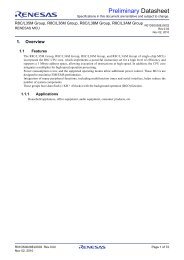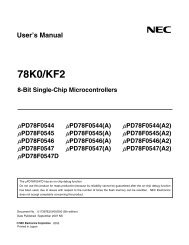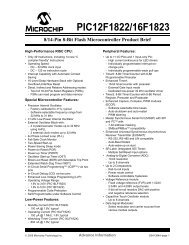xmega a3u - Elfa
xmega a3u - Elfa
xmega a3u - Elfa
Create successful ePaper yourself
Turn your PDF publications into a flip-book with our unique Google optimized e-Paper software.
XMEGA A3U<br />
22. TWI – Two-Wire Interface<br />
22.1 Features<br />
• Two Identical two-wire interface peripherals<br />
• Bidirectional, two-wire communication interface<br />
– Phillips I 2 C compatible<br />
– System Management Bus (SMBus) compatible<br />
• Bus master and slave operation supported<br />
– Slave operation<br />
– Single bus master operation<br />
– Bus master in multi-master bus environment<br />
– Multi-master arbitration<br />
• Flexible slave address match functions<br />
– 7-bit and general call address recognition in hardware<br />
– 10-bit addressing supported<br />
– Address mask register for dual address match or address range masking<br />
– Optional software address recognition for unlimited number of addresses<br />
• Slave can operate in all sleep modes, including power-down<br />
• Slave address match can wake device from all sleep modes<br />
• 100kHz and 400kHz bus frequency support<br />
• Slew-rate limited output drivers<br />
• Input filter for bus noise and spike suppression<br />
• Support arbitration between start/repeated start and data bit (SMBus)<br />
• Slave arbitration allows support for address resolve protocol (ARP) (SMBus)<br />
22.2 Overview<br />
The two-wire interface (TWI) is a bidirectional, two-wire communication interface. It is I 2 C and<br />
System Management Bus (SMBus) compatible. The only external hardware needed to implement<br />
the bus is one pull-up resistor on each bus line.<br />
A device connected to the bus must act as a master or a slave. The master initiates a data transaction<br />
by addressing a slave on the bus and telling whether it wants to transmit or receive data.<br />
One bus can have many slaves and one or several masters that can take control of the bus. An<br />
arbitration process handles priority if more than one master tries to transmit data at the same<br />
time. Mechanisms for resolving bus contention are inherent in the protocol.<br />
The TWI module supports master and slave functionality. The master and slave functionality are<br />
separated from each other, and can be enabled and configured separately. The master module<br />
supports multi-master bus operation and arbitration. It contains the baud rate generator. Both<br />
100kHz and 400kHz bus frequency is supported. Quick command and smart mode can be<br />
enabled to auto-trigger operations and reduce software complexity.<br />
The slave module implements 7-bit address match and general address call recognition in hardware.<br />
10-bit addressing is also supported. A dedicated address mask register can act as a<br />
second address match register or as a register for address range masking. The slave continues<br />
to operate in all sleep modes, including power-down mode. This enables the slave to wake up<br />
the device from all sleep modes on TWI address match. It is possible to disable the address<br />
matching to let this be handled in software instead.<br />
The TWI module will detect START and STOP conditions, bus collisions, and bus errors. Arbitration<br />
lost, errors, collision, and clock hold on the bus are also detected and indicated in separate<br />
status flags available in both master and slave modes.<br />
8386B–AVR–12/11<br />
42

















